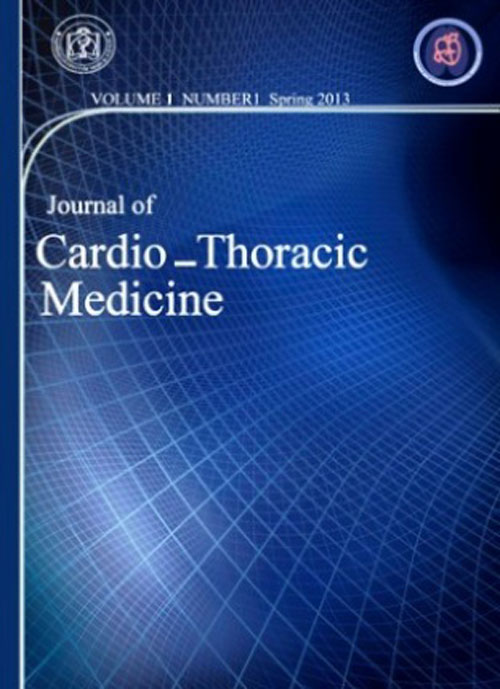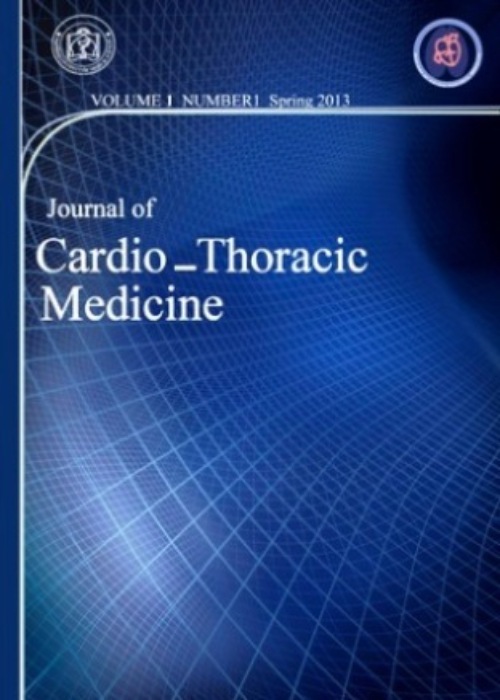فهرست مطالب

Journal of Cardio -Thoracic Medicine
Volume:6 Issue: 2, Spring 2018
- تاریخ انتشار: 1397/04/04
- تعداد عناوین: 8
-
-
Pages 274-281Diabetes mellitus (DM) as a chronic disease could lead to micro- and macrovascular disorder. Also, some evidence demonstrated that pulmonary involvement is more frequent in DM patients than the healthy population. Hence, we tried to perform a systematic search to considering pulmonary disease among the DM patients. Articles were identified through searching databases including PubMed, Google Scholar, Web of Sciences, Embase, and Scopus from 2000 to 2016. We reviewed systematically all studies reporting pulmonary disease among the diabetic patients. A total of 452 relevant records were identified by the electronic search, of which a total of 19 studies were identified as eligible papers that were original articles for the frequency of pulmonary disease among patients with DM. The incidence of pulmonary diseases has reported among diabetic patients that TB was reported to have a higher frequency when compared to other pulmonary disorder in diabetic patients. Therefore, conducting further studies on these two disorders is recommended, particularly in regions where the incidence of diabetes is increasing rapidly, and tuberculosis remains endemic.Keywords: Diabetes Mellitus, Pulmonary Diseases, Tuberculosis
-
Pages 282-286IntroductionLung cancer is the disease of modern era, and the rate of lung cancer mortality is three times as high as that for prostate cancer and twice as high as the rate for breast cancer. We aimed to analyze the results of pulmonary resection in patients with NSCLC by minimally invasive thoracoscopy.Materials And MethodsWe studied 10 patients with NSCLC scheduled for surgical resection by minimally invasive video-assisted thoracoscopic surgery (VATS) in Ghaem Hospital, Mashhad, Iran, during March, 2015-February 2016. The patients were analyzed with respect to age, gender, pathology, surgery type, surgical complications and turning into open surgery, hospital-acquired complications, and mortality rate six months and one year post-operation.ResultsWe found that 60% of the patients were male. The patients were within the age range of 47-75 years. The analysis of lesion location showed that most lesions were in the lower lobe of the left lung (50%). None of the VATSs turned into open thoracotomy surgeries. Postoperative complications were observed in 3 (30%) patients. Further, 5 (50%) patients had squamous cell carcinoma (SCC), 4 (40%) of the patients had adenocarcinoma, and 1 (10%) had LCC. The surgical mortality analysis of the patients showed that only one male patient (a 72-year-old patient) died five days after wedge resection due to myocardial infarction. In the six-months and one-year follow up of the nine remaining patients, no cases of death had occurred.ConclusionIt seems that pulmonary resection by minimally invasive VATS has considerable advantages compared to open surgery, including higher effectiveness, shorter intensive care unit (ICU) stay, higher survival rate, and greater patient satisfaction.Keywords: Pulmonary Resection, Minimally Invasive Thoracoscopy, Lung Cancer Surgery
-
Pages 287-290IntroductionCOPD is a common preventable disease characterized by airflow limitation that is not completely reversible.Acute exacerbation is prominent and serious features of COPD. Acute Exacerbation of COPD leads to hospitalization and concomitant with morbidity and mortality .The ventricular dysfunction increases serum Brain Natriuretic Peptide(BNP) . This study was conducted to evaluate the relationship between serum N-terminal pro b-type natriuretic peptide (NT-pro BNP) level and the severity of chronic obstructive pulmonary disease (COPD) exacerbation.Materials And MethodsThis cross-sectional study was performed among 140 patients with COPD exacerbation referred to Imam Reza Hospital affiliated to Mashhad University of Medical Sciences, Mashhad, Iran from March 2016 to December 2017 . The patients were asked about the number of exacerbations over the past year including the recent attack. The severity of COPD was determined by the measurement of forced expiratory volume in 1 second by spirometery and level of hypoxemia by pulse oximetery. Data analysis was performed using SPSS software, version 20.ResultsRegarding the results, COPD was more prevalent in males. The mean age of the patients was 57.60±9.76years old. There was a significant direct correlation between mean serum level of NT-pro BNP and age (P=0.01). Although mean serum NT-pro BNP level was higher in females patients (5.70±0.96) than males (5.66±1.24), no significant correlation was observed between mean serum NT-pro BNP level and gender (P=0.8). The most common chief complaints of the patients were dyspnea (97.9%), cough (88.9%), and phlegm (81.9%). There was no significant relationship between serum NT-pro BNP levels and the length of stay in hospital (P=0.1). However, there was a significant relationship between mean serum level of NT-pro BNP and COPD exacerbation (P=0.004). The mean serum level of NT-pro BNP was higher in the patients with more than two exacerbations over the last year in comparison to the other patients. Additionally, there was a significant direct relationship between mean serum level of NT-pro BNP and the severity of COPD (P=0.009). Moreover, a significant direct relationship was found between serum NT-pro BNP level and hypoxemia ( SpO2ConclusionThe serum NT-pro BNP level was a prognostic factor in the patients with COPD exacerbation.Keywords: Chronic Obstructive, Exacerbation, N-Terminal Pro B-Type Natriuretic Peptide, Pulmonary Disease
-
Pages 291-294Coronary artery disease (CAD) is a multifactorial problem. Although hyperlipidemia (HLP), diabetes (DM), and hypertension (HTN) are known as the familial and cardiac risk factors, CABG is rare in the several members of a family. We reported the six members of a family who presented with MI and/or advanced angina pectoris during the 6 years. CABG(Coronary artery bypass graft) considered for all patients due to involvement in main coronary arteries and clinical presentation. The ejection fraction (EF) was varied between 25% to 70%. Beating heart cardiopulmonary bypass (beating heart CPB) and off-pump were chosen as surgical method. The mean duration of surgery was about 4 hours. The only post-operative complication was deep wound infected in a young man who was smoker and drug abuser. According to family relationship of patients and the high effect of genetic penetration, we presume the gene influence to incidence CAD and potential to undergoing CABG, in members of a special family.Keywords: Genetics, Coronary Artery Disease, Coronary artery bypass grafting
-
Pages 295-300IntroductionCoronary artery disease secondary to atherosclerosis is the most common cause of mortality. Coronary angiography is the most precise method for determining the extent of disease in the coronary vascular bed. Arterial stiffness has been proposed as a marker of atherosclerosis in some studies. One of the noninvasive methods for the determination of arterial stiffness is Doppler echocardiography. In this study, we aimed to find the correlation between arterial stiffness as measured by echocardiography and the extent of coronary artery disease as evaluated through angiography.Materials And MethodsAortic pulse wave velocity (APWV) was measured by using the Doppler method in 70 patients, who were candidates for coronary angiography. The extent of coronary artery disease was determined quantitatively in terms of Friesinger index and semi-quantitatively as the number of vessels with stenosis of over 50%. Then, the correlation between arterial stiffness and these factors was evaluated.ResultsThe mean APWV was 9.1±5 m/s. There was a direct relationship between APWV and Friesinger index, which was not statistically significant (P=0.67). The mean APWV for patients with one-vessel disease was 4.4±1.8 m/s, while it was 9.9±3.6 m/s in patients with two and 7.9±4 m/s in three-vessel disease which did not show statistically significant difference.ConclusionDoppler echocardiography to measure APWV was not considered as a promising tool to predict the extent of coronary artery disease.Keywords: Arterial Stiffness, Blood pressure, Coronary Artery Disease, Pulse Wave Velocity
-
Pages 301-305Coronary aneurysms in adults are rare clinical entities. Herein, we presented a 54-year-old man who was admitted with an acute extensive anterior myocardial infarction. The emergency coronary angiography revealed an isolated large aneurysm at the proximal segment of the left anterior descending coronary artery. The patient was successfully treated with a graft-coated stentKeywords: Acute Extensive Anterior Myocardial Infarction, Coronary Aneurysms, Graft-Coated Stent
-
Pages 306-308Solitary fibrous tumor (SFT) is a rare mesenchymal tumor of the pleura, which arises from visceral pleura and projects into the pleural cavity. This tumor is not related to asbestos exposure or cigarette smoking (1). We report a rare case of SFT of the lung. In this case report, we present the case of a giant SFT in a 76-year-old woman who presented with the complaint of chest pain on the left side for several months; SFT was proved on examination.Keywords: Solitory Fibrous Tumors, Mesen?chymal Neoplasm, Pleura
-
Pages 309-312Subclavian Artery Thrombosis (SAT) typically arises secondary to some form of injuries and arthrosclerosis. The contributing factors are coagulopathies and emboli. And, the conserving blood is naturally reflowed from circle of Willis. A cold, painful, cyanosis, and pulseless upper extremity are proved as the symptoms. Recently, a 42-years-old smoker, diabetic, and hyperlipidemic woman was admitted with severe headache, vomiting, feeling weak, vertigo, decreasing of LOC and traumatic. Her left hand was pulseless, cold and painful and her blood pressure and force were significantly decreased. CT Angiography showed a large free gelatinous floating mass. The clot was completely removed by surgery and after that, left hand pulses and consciousness returned gradually. An unusual reason of acute upper extremity ischemia is thrombosis of subclavian artery. The percentage of symptomatic lesions is less than 1, but the same percentage in autopsy cases embraces 9% of the patient who have substantiate stenosis or obstruction of subclavian artery. All symptomatic patients should be treated emergently.Keywords: Subclavian Artery, Thrombosis, Trauma


